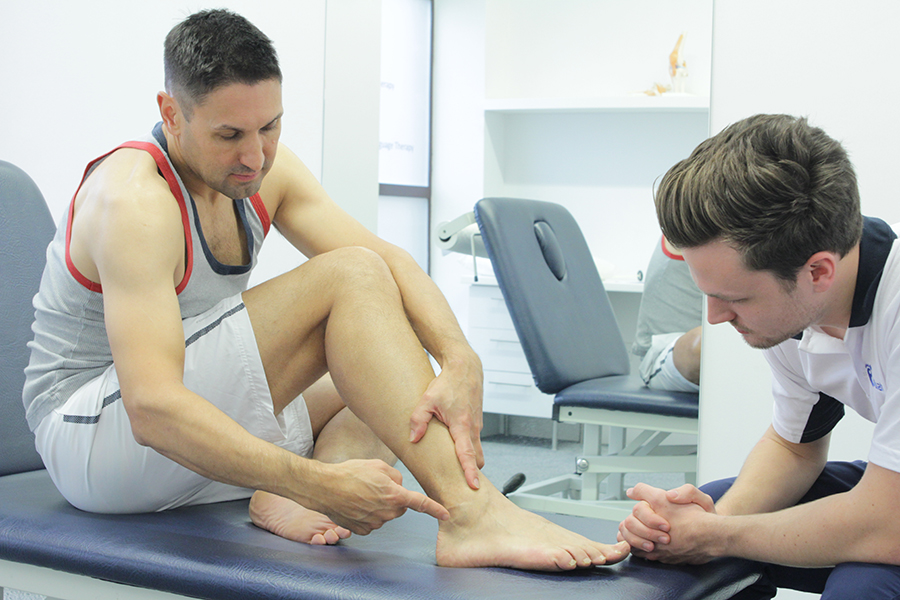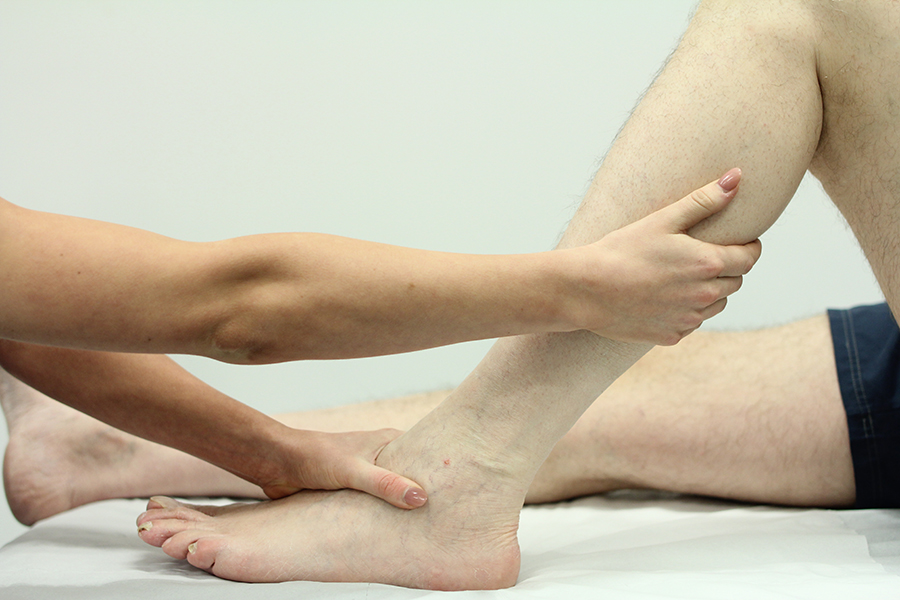Osteochondral lesion of the talar dome
Following appropriate treatment with crutches and/or immobilisation you will benefit from Podiatry. Podiatry can help improve any painful symptoms, increase the strength and flexibility at the ankle joint, as well as improve the over-all mechanics of your ankle, leg and foot.
What is an osteochondral lesion of the talar dome?
An osteochondral fracture of the talar dome is an injury to the cartilage that sits on a bone in the ankle called the talus. The talus and the tibia form the ankle joint, if the ankle is injured through fracture or sprain the talus and the tibia can collide against one another. When the tibia and talus collide damage can occur to the cartilage of the talus; this injury is called an osteochondral lesion of the talar dome. Osteochondral lesions to the talar dome vary in severity from bruising of the cartilage to an actual fracture of the talar dome.

What causes an osteochondral lesion of the talar dome?
The most common cause of an osteochondral lesion of the talar dome is an ankle sprain or ankle fracture. Those most at risk of an osteochondral lesion of the talar dome are those who participate in activities or sports that have a jumping element, as the compressive force exerted on the ankle when landing after a jump can damage the talar dome.
What are the signs and symptoms of an osteochondral lesion of the talar dome?
The symptoms of an osteochondral lesion of the talar dome follow an ankle sprain or similar injury. If you have an osteochondral lesion of the talar dome you will experience an aching pain, which will become worse when pressing the talus firmly. Any activity that requires you to place weight on the ankle will be painful; you may therefore have a limp as a result. The ankle joint will be swollen and you may have bruising. You will find the ankle joint difficult to move and it may 'lock'.
How is an osteochondral lesion of the talar dome diagnosed?
If you suspect that you have an osteochondral lesion to the talar dome it is important that this is diagnosed quickly and correctly so that future problems such as arthritis can be minimised. It is therefore advisable to visit A & E immediately after injury where you will have an X-ray or scan to confirm the diagnosis and assess the severity of the injury. It is vital that the severity of the injury is assessed as this will inform any treatment.
Benefits of podiatry for an osteochondral lesion of the talar dome
If you have had an osteochondral lesion of the talar dome you may benefit from podiatry following appropriate rest and immobilisation (if required). The benefits of podiatry treatment if you have had an osteochondral lesion of the talar dome are:
- To ensure optimal healing
- Prevention of future injury
- Improved ankle strength
- Improved ankle flexibility
- Improved foot and leg mechanics
- Improved gait
- Reduction of pain and stiffness
Podiatric treatment benefits following an osteochondral lesion to the talar
dome are achieved by improving any poor leg and foot mechanics, which is
achieved through a combination of orthoses, balance exercises, ankle
strengthening exercises, a stretching programme and ankle joint
mobilisation.
Orthoses improve lower limb mechanics by altering the way the foot
functions; they therefore improve the mechanics of the leg and foot and as
a consequence eliminate any pain or discomfort that you may have been
experiencing as a result of poor leg and foot mechanics.
Prescribed ankle exercises and ankle joint mobilisation help to keep the
ankle joint strong and flexible, which in turn prevents future injury and
improves any stiffness or pain that you may be experiencing. Pain and
stiffness in the foot and ankle is not only detrimental to gait and
posture, but also how you feel and your well-being.

What would podiatry for an osteochondral lesion of the talar dome involve?
At Chiropody.co.uk we begin each initial visit with a thorough assessment.
If you have had an osteochondral lesion of the talar dome we recommend that
you have a
biomechanical assessment
. The history is a vital part of the treatment process and covers topics
such as medical history, history of injury, and signs and symptoms.
Following the history taking the podiatrist will examine the foot and
ankle, assess the mechanics of your leg and foot, assess muscle strength,
and assess you walking (gait analysis).; All findings from the history and
assessment help the podiatrist to formulate a treatment plan. All treatment
plans are individual to you.
Following an osteochondral lesion to the talar dome, and any appropriate
rest and/or immobilisation of the ankle Manchester may prescribe the
following treatments for an osteochondral lesion of the talar dome:
- Orthoses
- Balance exercises
- Strengthening Exercises
- Stretching Programmes
- Joint mobilisation
- Advice and education
- Footwear review
Summary
An osteochondral lesion of the talar dome is an injury to the talus, which
is a bone in the foot that along with the tibia forms the ankle joint.
Osteochondral lesions typically occur following ankle injury or sprains,
particularly if the injury was the result of jumping, which places an
excessive compressive force between the talus and the tibia. When the talus
and tibia collide damage can occur to the cartilage that covers the talus,
or the talar dome can fracture. When the cartilage is damaged, or when a
fracture to the talar dome occurs this is called an osteochondral lesion of
the talar dome.
If you have had an osteochondral lesion to the talar dome and following any
appropriate rehabilitation you are still experiencing issues with either,
pain, stiffness and/or walking then visit Chiropody.co.uk. At
Chiropody.co.uk we will assess your leg and foot fully in order to put in
place a treatment plan that will aim to reduce any symptoms and improve the
function of your ankle, leg and foot.
If you would like to arrange an assessment with us at Chiropody.co.uk
please email office@chiropody.co.uk or call 0330 088 4222.
Save 5% by booking an appointment online.



We work with:

Individuals

Organisations

Health professionals
Get in Touch!
0330 088 4222
If you would like to speak to one of our specialists then please complete this form.
We are open 7 days a week








